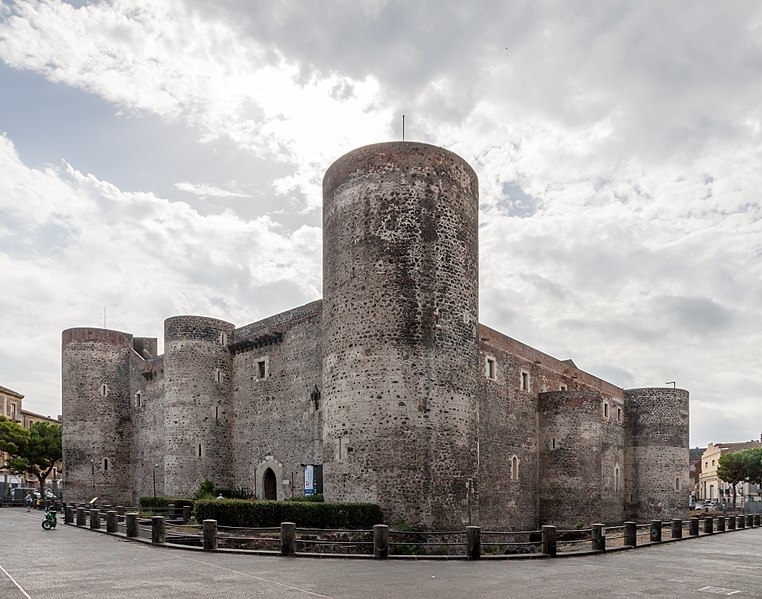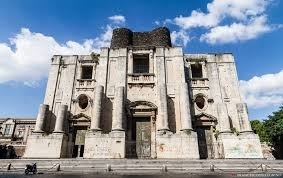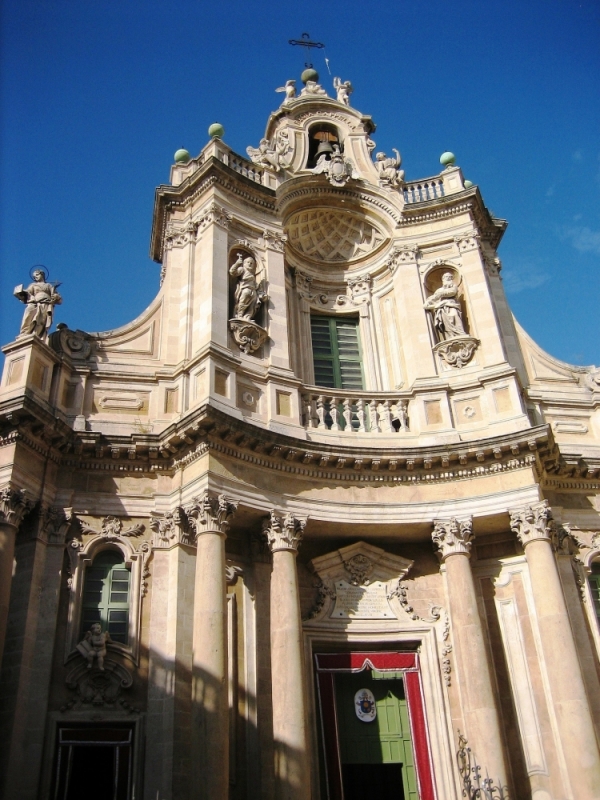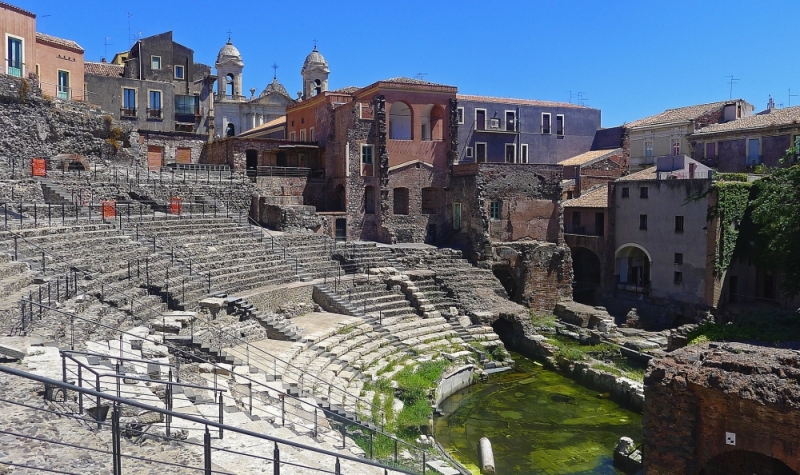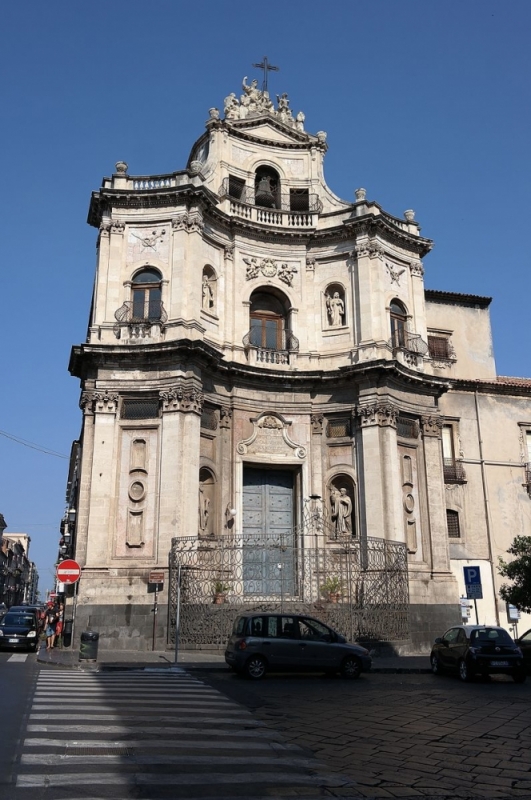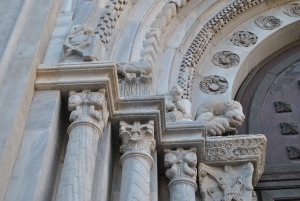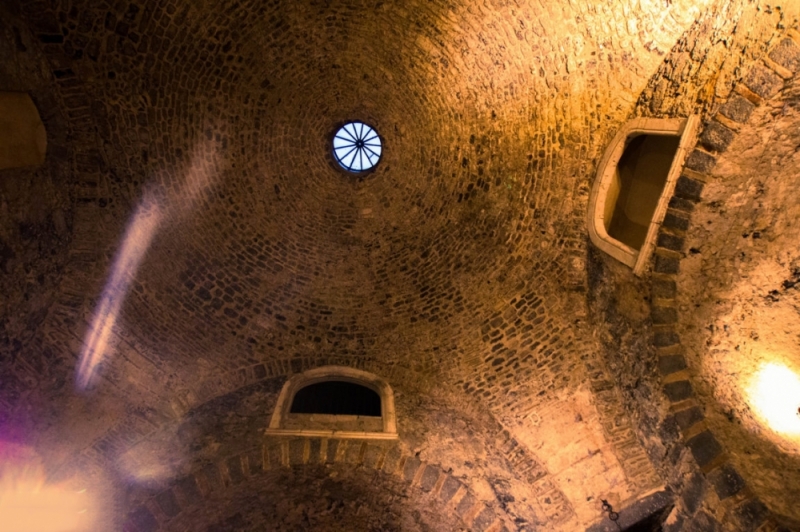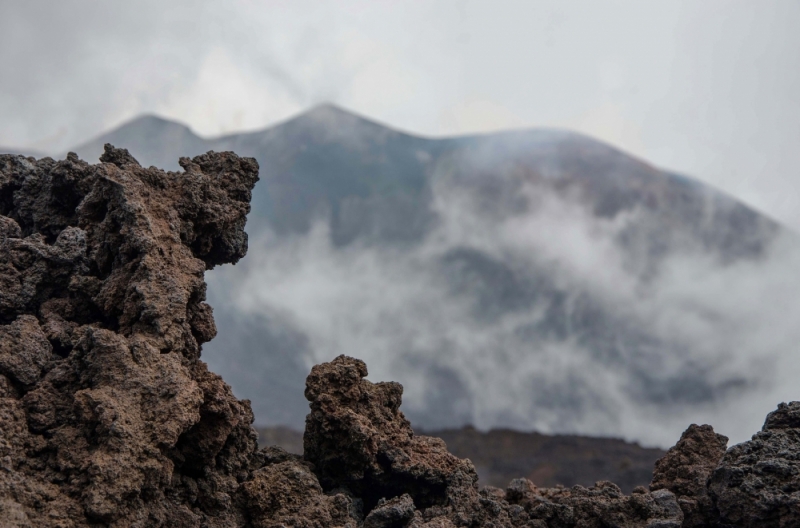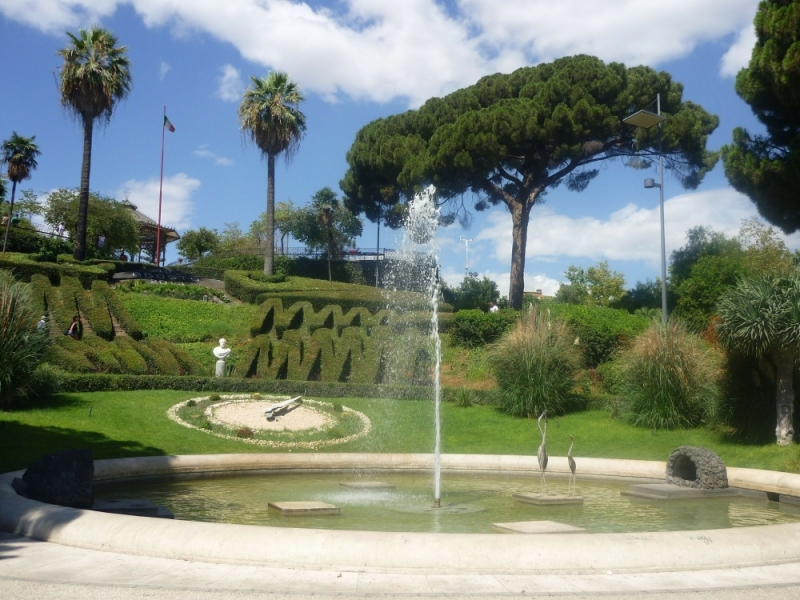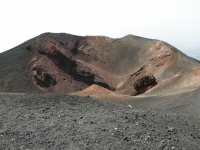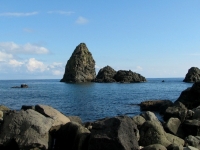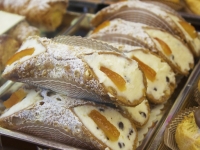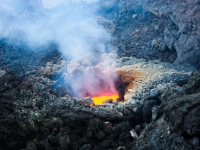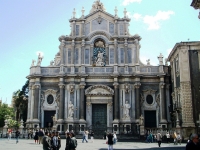Catania and its origins
The history of Catania , a Sicilian city, is twenty-eight centuries long, during which it was dominated by Greeks, Romans, Ostrogoths, Byzantines, Muslims, French and Spanish, until being annexed to the kingdom of Italy in 1860. Several times, over the centuries, destroyed and rebuilt several times, hence the nickname "La Fenice". In 729 BC the Greeks coming from Naxos founded the city under the name of Katane, which had its rise as a Greek commercial city until the 5th century. BC, when Hiero I came to power. The latter was a true tyrant: first he conquered Katane and then deported its inhabitants, transferring them to the city of Leontino (today's Lentini), calling the city after the nearby volcano, Aitna. The inhabitants were replaced with 10,000 inhabitants partly Greek and partly Syracusans. Following the death of Hiero, they were sent to the southern slope of Etna and the Katanoi were able to return to their city. The city was then destroyed following an eruption and, after being rebuilt, it was conquered by Dionysius I, who reduced the people to slavery and had the city colonized by Campanian mercenaries. The city managed to be reborn thanks to the fertility of its land and, with Roman domination, it became part, like Civitas Decumana, of the Roman province of Sicily. Demonstrating the period of rise are the amphitheatre, the Roman theater and the baths. It was with the Byzantine and Arab domination that the city lost its importance, and was downgraded to cities such as Syracuse and Palermo. Under the rule of the Normans, Catania regained its splendor as a maritime and commercial centre. Two events damaged the city enormously: in 1169 there was an earthquake in which 15,000 people died and, in 1194, Henry VI of Hohenstaufen assumed power, described in the books as a man greedy for power and glory or as someone who no one saw never smile. In 1434, with the foundation of the University of Catania, one of the oldest in Italy and, with the settlement of the Spanish Aragonese family, the city underwent a period of development, becoming the second city in Sicily. It was towards the end of the 16th century. and in the 17th century the city once again had a period of arrest: in 1576 a large part of the population was victim of the plague while, in 1669, there was another eruption which razed the western part of the city to the ground. Finally, in 1693, a strong earthquake destroyed what remained intact of the city. Catania, as in the past, managed to be reborn again thanks also to the projects of Giovanni Battista Vaccarini, returning to its original appearance.
What see
We advise you to start your tour from Piazza del Duomo , that is from the heart of the city. At the center of the square there is the Elephant Fountain , symbol of the city. According to legend, this statue has the power to stop the wrath of the Etna volcano. Also in the square, you can admire the Palazzo del Municipio of Catania, called "Palazzo degli Elefanti", built in 1693 after the earthquake, replacing the sixteenth-century palace "Palazzo Senatorio". It is the work of several architects including Giovanni Battista Vaccarini, previously mentioned, who designed some of the most beautiful buildings in the historic center. Behind the fountain is the Cathedral of Catania or the Cathedral of Sant'Agata , which you can visit for free and on any day of the week. The external façade was made of white marble, while the interior is dedicated to Sant'Agata, a virgin who was tortured after refusing the attention of a Roman prefect. GB Vaccarini decided to restore the church, while maintaining its original layout. He used many precious materials that came from the ancient monuments of Catania, in order to show the continuity between the present and the past.
Palazzo dei Chierici - Porta Carlo V - Castello Ursini
The Palazzo dei Chierici, also known as the Seminario dei Chierici, is connected to the Cathedral of Sant'Agata by an overpass that passes through Porta Uzeda. It was rebuilt after the earthquake of 1693, partly on the ancient walls and partly on an area occupied by the ancient Bishopric and today it is the seat of municipal administration. To the right of the building there is the Carlo V door , in the middle of the fish market, the daily market of fruit and fish. The Ursino castle was built by Frederick II of Swabia between 1239 and 1250, to fortify the city limits. In the past the castle was located near the sea but, during the eruption of 1669, it was surrounded by lava, which continued towards the sea, away from it. The castle returned to its original appearance following an excavation campaign. In the 1400s it became the seat of the Aragonese royal family and, following a restoration, it was the seat of the city's Civic Museum. The Benedictine Monastery was founded in 1558 and has been restored several times due to the catastrophes that hit the city. In 1977 it was donated by the Municipality to the University of Catania, thus becoming the Faculty of Letters and Philosophy. Following the restoration by the architect Giancarlo De Carlo, the monastery was recognized as a Contemporary Architecture Work.
San Nicolò Church - Via Crociferi - S. Benedetto Monastery
The Church of San Nicolò was built starting from 1687 on the project of the architect GB Contini. Following the earthquake of 1693, the works were continued by other architects such as Francesco Battaglia and Stefano Ittar and, it was the latter, who built the 62 meter high dome, even though the façade remained unfinished. The interior of the church, with three naves, is 105 meters long and the work that in the past made the church famous was the organ created by the abbot Donato del Piano and the great sundial, 93 meters long. After the post eruption reconstruction, Via Crociferi became the road to monasteries and churches: in fact, it is possible to find four churches, three monasteries and a college. Thanks to its beauty and the sacredness of the place, it was chosen as the location for many films, including "Storia di una Capinera" by Zeffirelli. The construction of the S. Benedetto Monastery began in 1334, but the entire building was reduced to rubble due to the earthquake, to which only five nuns survived. Church and monastery were rebuilt starting from 1708, thanks to the work of the architect GB Vaccarini and the painter G.Tuccari. The frescoes, mostly covered at the end of the XVIII century, re-emerged when in 1943 the building was struck by bombings and were restored thanks to the project of A. Dillon.
Santa Maria dell'Elemosina - Palazzo Biscari - San Francesco Borgia
The Church of San Francesco Borgia , located in via Crociferi, has a façade in Roman academic style. The interior has three naves, with marble side altars. According to some scholars, the Church of S. Giuliano was built by Vaccarini between 1739 and 1751. The church is surrounded by a wrought iron gate, and has an elegant appearance, thanks to its simple lines. The interior is a large octagonal space, in which the chapels and the altars reside. The Basilica of Santa Maria dell'elemosina (Collegiate ) was born in the first centuries of Christianity. The temple was frequented by the Aragonese kings and their court, taking the title of "Regia Cappella". With the bull of March 31, 1446, Pope Eugene IV formed a college of canons, and the basilica had the title of "Collegiate". Palazzo Biscari was built by Ignazio Paternò Castello, Prince of Biscari, to become his home. It is a building in Baroque style, built on the 16th century walls of Catania. Inside the palace there are about seven hundred rooms, even if the heart of the dwelling is in its halls. The British wanted to make it a defense post during the Second World War, but once they entered, seeing the architectural beauty of the building, they decided to stay there.
Roman Theater - Amphitheater
The Roman Theater, in the center of Piazza Stesicoro , was built during a period of time ranging from the 1st to the 4th century AD, and could hold about 7000 spectators in the past. The chromatic alternation of white and black, characteristic of many Catanese buildings, gave the monument a touch of elegance. From the architectural point of view, the amphitheater is formed by a cavea of 14 steps divided into three orders, with a podium and ambulatory access to the tiers arranged on three floors. The external circumference is 309 meters and could hold up to 15,000 seated spectators. Probably the building dates back to the middle of the 2nd century BC The University Palace is dominated by the University building , built by order of King Alfonso of Aragon in 1434. The history of the building, how we can admire it today, begins in 1969, three years after the earthquake, when reconstruction work began on the old foundations. To date, the University of Catania, which has over 53,000 members, has several locations in the city. The Teatro Massimo Bellini, which overlooks the square of the same name, was inaugurated on 31 May 1890, with the representation of the Norma by Vincenzo Bellini. The building, as it appears today, has been restored by Carlo Sada.
Palazzo Cultura - Church of San Francesco Assisi - Chiesa San Michele
The Palazzo della Cultura, formerly Palazzo Platamone and Monastero di S. Placido , occupies an entire block of trapezoidal shape. It is a jewel of Baroque art and its façade was created by Stefano Ittar (1769). The history of the Church of St. Francis of Assisi refers to Queen Eleanor of Anjou, wife of Frederick II of Aragon: a plaque states that her remains are kept in the church. Inside the church it is possible to admire paintings and paintings dedicated to the queen. In 1625 the regular Minorite clerics arrived in Catania. The latter, in 1628, built the church of San Michele, which was then demolished by the earthquake of 1693 and rebuilt again thanks to the assets left in inheritance to the religios, by Giambattista Paternò. The church was rebuilt according to a basilical plan, with the three naves divided by pillars, the floor elevation and the dome, which were completed in 1787. In Piazza Stesicoro, right in front of the ruins of the amphitheater, we find the church of S. Biagio . The style of the facade dates back to the late eighteenth century. The origins of the church date back to 1098, but it was rebuilt and rebuilt after the earthquake, at the behest of Bishop Andrea Riggio. In one of the two chapels, in particular the one connected to Sant'Agata, the famous "furnace" is preserved, an instrument that at the time was used for torture.
In the Sanctuary of Sant'Agata al Carcere, according to the story handed down by the Acts of Martyrdom, the young martyr was imprisoned here after having spent 30 days in the home of the matron Aphrodisias. It is precisely within this prison that the earthly life of the martyr will end on February 5, 251, following the famous martyrdom of the furnace. The Sanctuary of SS. Annunziata al Carmine dates back to the mid-13th century, when the Carmelites arrived in Sicily. The church had the protection of the Sveva family, in fact in the apse of the high altar there is the coat of arms enriched by the insignia of the Swabians in Sicily. To the north of the ancient theater we find the thermal building called "la Rotonda ", a closed circular building, with marble arches and basins inside. Below the floor and a crypt, ancient constructions emerged, which were ordered according to a chronological scheme: remains dating back to the Hellenistic-Roman period - repressive of the imperial age - retrenchment of the late Roman age - the Byzantine floor - some restorations dating back to the Middle Ages - more recent details, from the 17th or 18th century
Achillian Baths - Buonajuto Chapel - The bastion of the Infected - The door to beauty
The Achillian Baths , are underground thermal structures dating back to the IV-V century, of which a small part remains visible from Piazza Duomo. The beautiful Cappella Buonajuto , datable between the 6th and 9th centuries AD, it is one of the few buildings left undamaged by the Byzantine era and resides inside the Baroque palace Buonajuto and is located 3 meters below ground level. The building, with inside medieval and fifteenth-century testimonies, has managed to escape the earthquakes that hit the city. The building was restored in the 1930s by Paolo Orsi and Sebastiano Agati, and today it is also home to numerous events. The spas of the Address have this name because they are partially part of the former convent of S. Maria dell'Indunica. Inside this building, remains of furnaces that were used to heat the thermal rooms are preserved. The bastion of the Infected, is the only one remaining whole among those of the city walls of Catania, and dates back to the sixteenth century. It is visible only inside because, on the outside, it is covered by buildings. The door of beauty is the largest terracotta sculpture in the world. Inside, there are nine thousand terracotta forms for 12 monumental works, made by national artists. The works are inspired by the theme of the "Great Mother" and appear accompanied by poetic texts.
Etna volcano
Among the many wonders to visit in Catania, surely, the Etna Volcano is not to be missed. With its 3350 m, it is the highest active volcano in Europe. It is an almost obligatory stop, but it is necessary to plan it well, taking into account the time you have at your disposal and the type of visit you want to make. Etna in fact offers many different possibilities as there are many agencies offering activities on the volcano. Etna is often in activity but unlike volcanoes such as Stromboli, in the Aeolian islands, incandescent lava is visible only at certain times, during an eruption. During these periods of activity, from a safe distance or from the piedmont countries it is possible, especially at night, to admire the red tongues of fire. It is also possible to visit the extinct craters, among which the most important are the "silvestri craters", located on the south side of the volcano, on the Nicolosi side. A stage, before reaching the craters, you can do it at an altitude of 1900 m where the Sapienza Refuge is located (reachable also by private cars or organized buses). From Piazzale Etna it is possible to take the Etna cable car which will take you up to 2500 m. With an integrated cable car + off-road bus ticket, they will take you up to 2900 m of altitude in a truly spectacular route. There are also numerous Jeep Tours. In winter, on Etna, it is also possible to ski thanks to the facilities and the many local services.
Movida and entertainment
The city of Catania, full of clubs, offers many ideas for those who want to have fun. The historic center is the heart of the nightlife, thanks also to the work done to redevelop the place. The golden square is between Piazza Duomo, Piazza Università and Piazza Teatro Massimo where we find a lot of places, in a Baroque style frame. During the summer, these places are transformed into Concerto Cafés, where numerous events take place. At the end of the evening, you can stop in one of the cloisters and taste a seltz lemon and salt (a typical Catanese drink).
Bellini park
Near via Umberto and Villa Bellini, there is vico Santa Filomena: a street where you will find characteristic restaurants and cocktails created by professionals. For the youngest, the ideal area is Piazza Teatro Massimo, where young and very young people gather to have a drink or a "shottino". For the romantics there is instead the area of the port, where in addition to the cafes there are the silos, (which anciently were pits for storing wheat). Today they represent one of the largest murals in the world. For night owls, there are numerous open-air H24 bars in Catania, where you can enjoy a good croissant or some local specialties, or perhaps watch the sunrise from the hamlet of San Giovanni Li Cuti. Most nightclubs are located in the sea area and in the historic center. As the aperitif is now a moment of socialization, we recommend the coolest places to have an aperitif: The 22 Lounge bar is one of the places that best represent the Catania nightlife. There are excellent cocktails, spirits and a select clientele. International aperitifs and evenings with DJ sets are also organized. The Cortile Alessi is located near via Crociferi and, in a location that is a fusion of rustic and modern, you can also taste typical local products. The First, in San Berlin District, is located in the heart of the historic center, and is considered one of the most beautiful places in the city. There is a fantastic outdoor space with flowers and wooden furniture and also a fantastic selection of craft beers. If you are in Catania in the summer, we have fantastic beach bars to recommend: Le Capannine is a Caribbean-style beach bar, where you can enjoy both happy hour and disco. The Afrobar is among the trendiest places in the city and also one of the most transgressive. Organize themed events and evenings with international artists and DJs, such as Joseph Capriati, Carl Cox, Nina Kravitz, The Martinez Brothers and many others. If after the happy hour you feel like taking a trip to the disco, we have some nightclubs to suggest: the Discotheque Ma is both a cool and a great restaurant, with a contemporary design and a particular clientele. The Banacher nightclub is a room carved out of lava stone, with a swimming pool surrounded by exotic plants and is frequented by a select audience. For those wishing to try local cuisine, we recommend typical restaurants, such as Locanda Cerami, Gambero Pazzo, CaScia ou Fucularu.
Climate, curiosity and advice
Climate: the city of Catania has a Mediterranean climate, with some subtropical and continental features. Winter has average temperatures of around 11 degrees and guarantees rather mild daytime temperatures, but the temperature range compared to night-time is quite evident. Summer is very hot, while temperatures are more moderate on the coastal strip.
Curiosity: If you are a street-food lover, you should definitely try the stuffed Arancini di Riso. Be careful not to miss it: here they are called "Arancini", while "Arancine" is what they are called in Palermo. Catania, after the eruption of Etna in 1669, was rebuilt in Baroque style, especially by Giovan Battista Vaccarini. It was in this city that the great Vincenzo Bellini was born, one of the greatest operas of the nineteenth century. The Teatro Massimo, dedicated to him, is one of the temples of opera in Italy. During the Summer Festival in Catania, walking through the historic center, you can choose between interesting activities. The Ursino Castle, built by Frederick II, is one of the few Norman monuments that survived the eruption, even though it was originally built on the sea, while after the eruption it moved away from the coast. Catania was also the city of one of the most famous physicists of the twentieth century, Ettore Majorana, who disappeared in 1938; in this regard many hypotheses were made: that he escaped to Argentina, to Germany, whether he dressed as a tramp, or that he retired to monastic life, a hypothesis endorsed by Sciascia in a famous novel.
Tips: if you arrive by plane, from the Fontanarossa airport, you can reach the city by taking the AMT “ALIBUS” bus for the modest sum of 4 euros. Moreover, in Catania there are many museums to visit and, to move without problems between museums and public transport, we advise you to do the Catania Pass.



